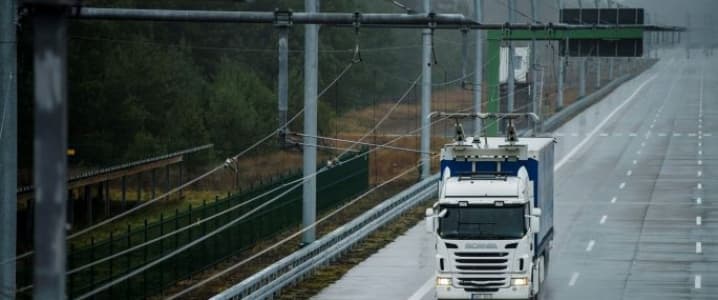There are millions of trucks on the world’s highways at any given time, carrying cargo from one place to another and spewing diesel exhaust fumes. That’s how it’s been since the dawn of trucking, that’s how it still is. But that’s not necessarily how it will be in the future.
Electric trucks are a fact, though not a very popular one, which is undeserved to a certain degree. While short-haul deliveries are perfect for utilizing electric freight carriers, a long-haul electric truck would need a battery weighing 23 tons to be able to make a 500-mile journey in one go. That’s a lot of battery – basically half of the truck’s own weight.
Yet Siemens and Scania have recently unveiled an alternative to these monstrous hypothetical batteries: a truck that uses a pantograph feeding it power from wires running above it. Just like a trolley or an electric train. Unlike trolleys and electric trains, however, these Scania trucks (two test ones for now) can detach from the wires to overtake another vehicle or switch lanes for any other reason, and then smoothly return to the electrified lane because they also have internal combustion engines (that run on biodiesel), as well as battery-powered electric motors. These two motors allow the truck to “hop” from one electrified portion of a highway to another.
Related: In World Of $50 Oil, Shale Beats Deepwater
Trucks run on diesel. Many passenger vehicles and power plants also run on diesel, of course, but trucking is one of the main domains of diesel. For now, the International Energy Agency forecasts continual growth in diesel demand, especially from emerging economies. India in particular will drive diesel demand with a more than twofold increase by 2040. In Europe, however, diesel demand is falling as more sustainable renewable options come onto the market.
Twenty-four years is a long time, and such long-term forecasts as IEA’s to 2040 are uncertain at best. India’s economy is indeed likely to begin devouring a lot more diesel than they do today, but whether this momentum will stay through 2040 is far from clear.
The electrified section of the E16 highway in Sweden will be used to test the trolley-trucks for two years before Siemens and Scania announce next steps. Sweden has pledged to go completely fossil fuel-free by 2030. Electric trucks have already proved they could be more cost-efficient than fossil fuel-vehicles, albeit just in the short-haul segment for now. If the two-year tests on the E16 turn out to be a success, they could provide a major push towards greater adoption of trolley-like trucks and electrified highway lanes.
By Irina Slav for Oilprice.com
ADVERTISEMENT
More Top Reads From Oilprice.com:
- The Hague Tribunal Ruling On South China Sea Raises Tensions
- U.S. Production Is Falling, Why Isn’t Oil Recovering Faster?
- Does This Estimate Suggest We Are Heading For $30 Oil?



















"Charging" or transfer pad would be embedded in the road transferring electrical power to the EV. Instead of running off the vehicle's battery system, the electric motor is being powered via the pads in the road. Such a system already exist and has been tested in England.
The “trolley” system is a giant step backwards when one realizes the same could be accomplished through a series of “power pads” implanted in the road way.